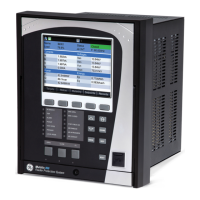7–42 850 FEEDER PROTECTION SYSTEM – INSTRUCTION MANUAL
TRANSIENT GROUND FAULT DETECTION CHAPTER 7: MONITORING
If Peterson coil conductance is calculated as |Red (Peterson coil)| = |Purple (faulty feeder)|
+
|Green (healthy feeder)|, then it is resonant compensation and there is no fault current.
There are three categories of Peterson coil compensation, based on the degree of
compensation: resonant compensation, under (capacitive) compensation, and over
(inductive) compensation.
A patented algorithm is used, which does not require special hardware of high-acquisition
frequency to precisely determine the fault direction. Sub-harmonic residual voltage and
current band pass filters are implemented in the TGFD design. After residual voltage and
current signals pass through the band pass filter, VN becomes VN’ due to the 90° shift:
As a healthy line is capacitive and a faulty line is inductive, we can say that:
• For VN’ and IN in opposite directions, the feeder is faulty (forward) so the transient
reactive power is negative.
• For VN’ and IN in the same direction, the feeder is healthy (reverse), so the transient
reactive power is positive.
Figure 7-24: Power characteristics
The Power characteristics figure shows Active Power (P) and Reactive Power (Q). The small
P/Q area is represented by the small green rectangles from (2, 5) to (-2, -5).

